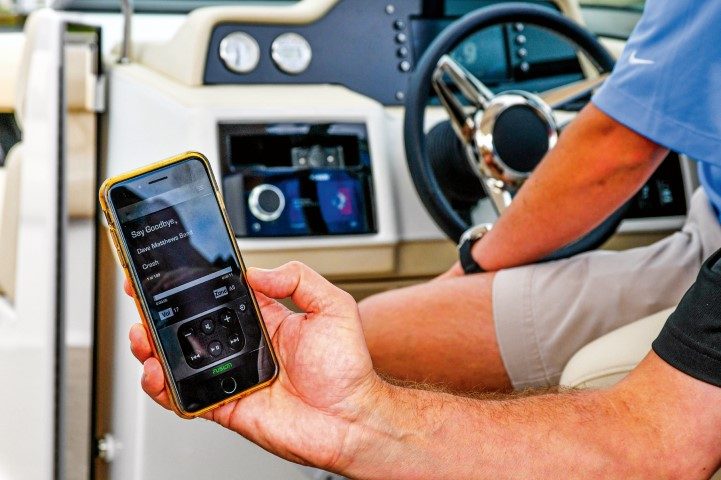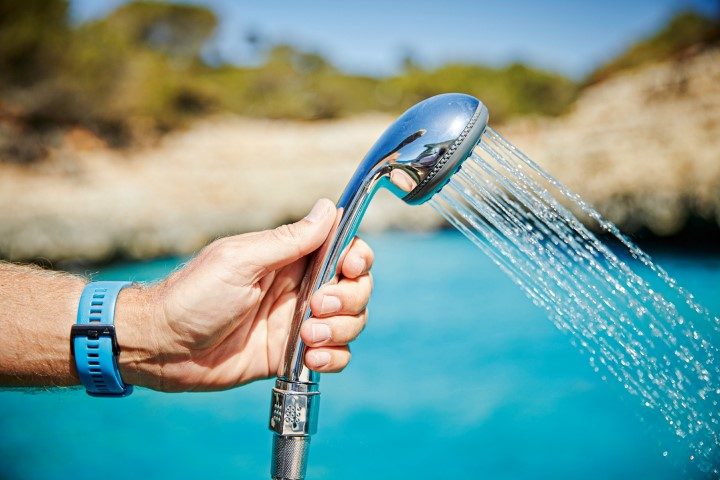

Boatbuilders and equipment manufacturers worldwide have released a tsunami of innovation in recent months. From automated docking systems to phone-controlled toilets, the sheer volume of new technology going into boats is absolutely staggering.
Craig Ritchie takes a look at 10 trends to expect in 2020.
When was the last time you walked through a boat show or spent an afternoon at the local dealership? If it’s been a while, you’re likely in for a shock. With the global economy firing on all cylinders, boatbuilders and marine equipment manufacturers have unleashed a torrent of innovations as they each attempt to leapfrog their competitors and grow market share.
Most would agree that a five-year-old smartphone is out of date, and it’s no stretch to say the same for a boat of the same vintage. The veritable flood of technology gaining critical mass in the last two or three years doesn’t just change the bits and pieces installed on a boat, it changes everything – from the materials used to make the hull to the way that it’s assembled to the way you make it run. A new boat built today is nothing like one built a decade ago, and things will change even more in the 2020s.
If you’re thinking this might be the year for a new boat, you’re going to see all sorts of new trends coming to market – great innovations that make boating safer, more comfortable and more enjoyable than ever before.
CONNECTED BOATS
We live in an increasingly connected world, and that extends to things that float. Virtually every boat on the market today now comes with some level of wireless integration, from simply allowing you to stream music to the stereo from your smartphone over Bluetooth, to being able to operate major elements of the rig remotely.
Streaming media from a phone or tablet to the stereo by Bluetooth has become standard but look for newer systems like New Zealand builder Fusion’s Apollo line that stream over Wi-Fi instead. Wi-Fi delivers much better sound quality than Bluetooth because it doesn’t clip the highs and lows the way Bluetooth does, and it’s a difference that virtually anyone can clearly hear.

On bigger yachts, remote operating systems operate more than just the stereo – they also let you remotely fire up the air conditioner as you make your way to the marina, for example, so the yacht’s already nice and cool when you arrive. Being able to similarly start the refrigerator from home ensures that the beer will be nice and cold by the time you arrive.
SECURITY AND REMOTE MONITORING
Everyone wants a boat, including people who have absolutely no intention of paying for one. To make sure that your pride and joy doesn’t suffer an unscheduled change of ownership at the hands of thieves, boatbuilders are increasingly offering remote monitoring systems as either available options or even as standard equipment.

Smartphone apps let you keep tabs on your boat’s location at all times (handy if you’re worried someone may be using it without your knowledge), while advanced systems alert you (or the police) if it leaves the dock without you. More advanced systems let you monitor things like water levels in the bilge (helpful after a rainy weekend) as well as shore power systems or battery levels, so you can be assured your automatic bilge pumps really will keep pumping that rain out. Others with motion sensors can even alert you if someone steps aboard, or if the local wildlife decide to move in while the boat’s in storage.
STABILISERS
Once upon a time fancy stabilising systems were only found on luxury cruise ships and mega-yachts owned by Bond villains. Today, they’re available for boats down to around 8m, including open models like center consoles and RIBs.
Gyro systems like the Seakeeper counter the rolling sea with a rapidly spinning flywheel that really works, so that sitting on a boat in a heavy chop now feels as secure as sitting at your kitchen table. Best of all, as the technology becomes more widely adopted, prices have been plummeting.

Even less expensive automatic trim tab systems also provide a much more stable ride and are becoming standard on many boats, although unlike gyros they only work when the boat’s underway.
ASSISTED DOCKING IS COMING FAST
Years ago Volvo Penta raised eyebrows worldwide with its innovative joystick docking control on boats powered with its then-new IPS propulsion system. For the first time, boaties could slide their craft into the slip with ease by simply pushing or twisting a little joystick.
Joysticks have since become increasingly common on both pod-drive inboard and outboard-powered multi-engine boats of all kinds. The latest systems, like Raymarine’s Dock Sense setup, pairs this technology with proximity sensors linked to a CPU that can not only display the boat’s relative position to the dock on your MFD, but actually take over control if you botch it, automatically adjusting the boat’s position to prevent an accidental collision with another boat or the sea wall.

It works so well that it becomes virtually impossible to hit anything – to the point you have to press a button on the dash and override the system in order to make physical contact with the dock. Now anyone can look like a seasoned pro.
HERE COME THE DIESEL OUTBOARDS
We’ve all been watching the horsepower race at the back of the boat as outboards grow bigger and more powerful with every season. But more recently diesel outboards have also entered the fray, and the companies promoting them say they offer some appealing advantages.

At least two builders – Oxe and Cox – are coming to market this year with 300hp diesel outboards said to offer far more torque than comparable petrol models, along with lower maintenance requirements, far greater fuel economy, greater operating range and significantly lower emissions. It all comes at a cost, of course, and unless you run the boat a lot it might take a while to achieve a return on the added investment. Still, diesel outboards hold promise for those who put on enough hours to warrant the expense.
HIGH-TECH HEADS
If there’s one place where we’re all going to see major changes on a boat, it’s down below in the bivvy. Heads have gone high-tech, and in both form and function.
The old-school porcelain jobs with their ubiquitous pump handle are increasingly giving way to streamlined electric heads that take care of business quickly, quietly and effortlessly at the push of a button – more like you’re finishing up in an airliner than aboard a boat.

Carbon-fibre bowls offer a more contemporary look while providing opportunities to add features like integrated bidet functions – including a blow dryer and even a little puff of perfume afterward, if you wish. Heated seats with integrated massage function are becoming popular upgrades on high-end yachts, while at least one toilet on the market – made by Raritan – is Bluetoothenabled so you can flush it remotely with a smartphone. And no, we’re not kidding.
MORE, BIG MFDS
As always, some of the biggest innovations coming down the pipe are in electronics, with manufacturers like Lowrance, Simrad, Raymarine, Garmin and Humminbird bringing out huge new touch-screen monitors that display everything a boatie ever wants to know in a single space.

These multi-function displays do so much more than just display your fish finder data – in split-screen mode they can simultaneously function as a GPS chartplotter for precision navigation, operate the stereo or remote equipment like cameras, display engine data or just about anything else that can be connected over an NMEA2000 protocol. High resolution screens with remarkable clarity have made old dial gauges completely obsolete.
DOCKING CAMERAS
High-end SUVs were the first vehicles to introduce rear back-up cameras to the mass market and since then, everyone wants one in their truck. Wouldn’t it be great to also have one in a boat?

Well now you can. Docking cameras make it a cinch to see exactly how far you are from the dock, even when bringing a bigger boat in on the opposite side of the helm. It’s a huge plus in a pontoon boat, where you can’t see past the seats, and essential in a cruiser or a big centre console. While they don’t offer quite the same level of sophistication as the sensor-controlled docking assist systems, they cost far, far less and provide real benefits that anyone can appreciate.
MAINTENANCE-FREE BOATING
It seems like everyone has a busy schedule these days, so when it comes to boating, people want to spend time enjoying their boat – not cleaning it. As a result, maintenance-free is the new buzzword.

Replacing traditional fibreglass nonskid or marine carpet with durable woven flooring or EPA foam pads mean you just give the boat a quick shot with the hose at the end of the day and walk away. New upholstery materials provide the look and feel of fabric while retaining the stain resistance and wipe-clean convenience of vinyl – and without the pink spots. Transom showers are becoming standard equipment on more and more models – not for spraying off sandy feet, but for blasting off fish scales or spraying out the cockpit at the end of the day. No muss, no fuss.
UNDER COVER
Skin cancer and sunstroke are not to be taken lightly, which is why more and more open boats are now coming with some sort of top as standard equipment. Even smaller centre-console fishing boats and RIBs are now designed from the outset with a top in mind, while larger rigs can be found with retractable awnings that extend to provide as much shade as desired.

Best of all, many of these shades and tops are available on the aftermarket, making it easy to retrofit an older boat. Because let’s face it, safety and comfort are a priority for everyone.




